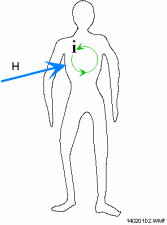


Exposure to a static electric field does not produce a significant field inside the body, but instead leads to the build up of electric charges on the body surface. In contrast, magnetic fields are virtually as strong inside the body as outside, which can lead to interactions within the body.
Experimental data have established that static magnetic fields can interact with different components of the body in the following ways:


The interactions of biological tissue with a static magnetic field depend on the physical properties of the field such as the strength and direction of the field at a given place inside the body.
The interactions with biological tissue that are likely to be of most consequence for health occur when there is movement in the field, such as body motion or blood flow. Movement in a static magnetic field can induce an electric field and current in the body, which may account for the reports of vertigo and light flashes (phosphenes) from people moving in fields stronger than 2000 or 3000 mT.
Computer models and direct measurements are used in order to estimate the strength of the internal electric fields in humans or animals that are induced by a given magnetic field. Induced electric fields are estimated to be substantial during normal movement around or within a magnetic field of more than 2 000 or 3 000 mT.
There are many sources of exposure to static magnetic fields, but one of the strongest and most common is Magnetic Resonance Imaging (MRI) equipment. In the past decade, the field strengths used in MRI equipment has increased significantly. The most common system in current clinical use has a field of 1 500 mT, but more than one hundred 3 000 mT -systems were already operational worldwide in 2004. Systems ranging from 4 000 to 9 400 mT are now being developed for clinical imaging.
With this move towards high field strengths, understanding the interactions between the fields generated by MRI systems and the human body has become more important since the potential for interactions increases accordingly. This can be studied through further computer modelling as well as experimental observations. More...

This summary is free and ad-free, as is all of our content. You can help us remain free and independant as well as to develop new ways to communicate science by becoming a Patron!